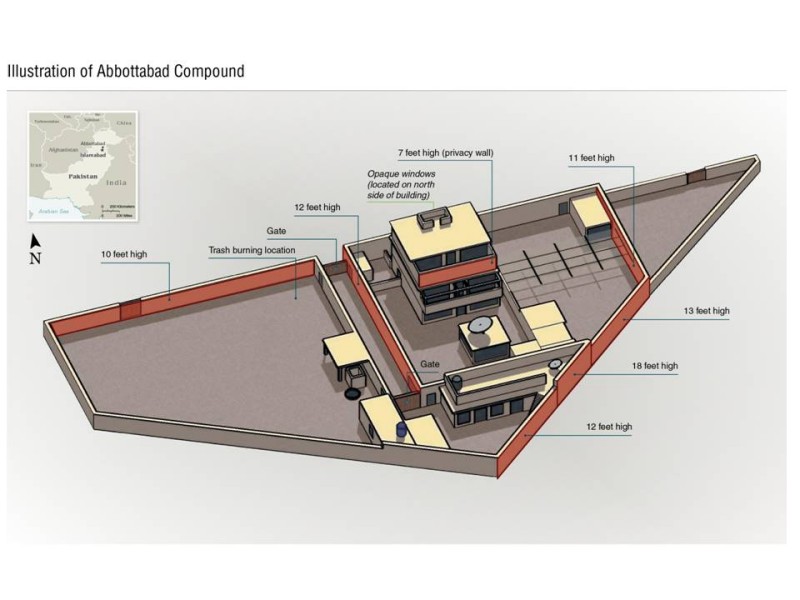 |
| Diagram of Osama bin Laden's compound in Abbottabad, Pakistan |
Document: Abbottabad Commission Report [PDF]
Length: 336 pages
Document Date: Undated,
released by Al Jazeera, July 8, 2013
Notes:
336 pages, but double-spaced and a fast read. Paragraphs are numbered,
which is nice, and I refer to them below. Also, Osama bin
Laden is referred to as OBL throughout. The released document is a PDF,
though image-only, so text is not searchable or crawlable. All names
are spelled as they appear in the report. Also, this is in the format I use for my Tumblr blog,
Dumb Things I Have Read Lately, but I decided to post it here since it's way longer.
Commentary:
Since last week's release by Al Jazeera of the
Abbottabad Commission's report
on the May 2, 2011 US Special Forces raid on Osama bin Laden's compound
in Pakistan, lots of folks have been trying to pick juicy tidbits from it.
For example, the
Daily Mail noted that
"Osama bin Laden wore a COWBOY HAT around the house to avoid detection." (Featuring an artist's conception of what Osama in a cowboy hat might look like.)
Beyond the goofy bits, the
primary theme of the Abbottabod Commission's report is incompetence, at every level of government.
In fact, if you made a drinking game from the report, and took a shot every time "incompetence" showed up,
you would probably die:
The word shows up at least 16 separate times: paragraphs 8, 152, 203,
414, 595, 604, 676, 692, 703, 710, 727, 728, 790, and 794 (counting one
"lack of competence," but not counting its appearance in questions).
In
many cases, incompetence by individuals and lower-level government
agencies is attributed to or exacerbated by systemic problems of
ineffective institutions afflicted by corruption, conflict of interest,
lack of policy guidance, and generally poor governance.
For example, the "incompetence" of a local police official, the Regional Criminal
Investigation Officer, is attributed to "governance implosion
syndrome." (p. 78, ¶152)
The report
is breathtakingly harsh in its criticisms. It is a thesaurus of pejoratives for poor administration, including:
Gross negligence, indifference, confused and incoherent, grave
dereliction of duty, active connivance, unprofessional, grave lapse of
professional judgment, woeful lack of efficiency, considerable
ignorance, systemic failures, grossly irresponsible, shameful,
dysfunctional, and policy bankruptcy.
Here are 36 other items from the report.
bin Laden's 5-Hour Energy:
Also in the paragraph about the cowboy hat (p. 41, ¶48), the report noted that "...whenever
OBL felt sluggish he would take some chocolate with an apple."
Like: Watching Plants Grow:
"OBL personally saw to the religious education of his grandchildren and
supervised their play time, which included cultivating vegetable plots
with simple prizes for best performances." (p. 41, ¶49)
Escape by a Whisker:
During his travels in Pakistan, OBL was clean shaven (p. 44, #55). It
was also during this time that the car in which he was traveling to the bazaar
was stopped for speeding by a policeman. All inside were free to go
after the driver quickly settled the matter. (p. 45, ¶57)
No More TV for You:
According to Maryam, wife of courier Ibrahim (al-Kuwaiti), her
9-year-old daughter Rahma was told that OBL didn't leave the house to go
to the bazaar because he was too poor to buy anything, As a result, she
then referred to him as "Miskeen Kaka" (poor uncle).
Rahma
subsequently recognized OBL in a news report on al Jazeera, causing the
ladies to then lose their TV privileges. (p. 47, ¶62-63)
In paragraph
73, the commission notes it did not find aspects of Maryam's testimony
convincing.
Houseguest From Hell: Also according
to Maryam, while they lived in Swat, they were visited for two weeks by a
man named Hafeez, with his wife and seven children. A month later, they
learned of his arrest, and his real name: Khalid Shaikh Muhammad. (p.
45, ¶58)
A Flood of Information? The Commission
speculated that US pilots may have "directly or indirectly benefited
from the US flood relief air operations of August-October, 2010 in the
same general area" of the raid's inbound flight path, noting that the US
had identified the Abbottabad compound by this time. (p. 52, ¶76)
Later,
though, Director General Military Operations says during flood relief
operations, US pilots were accompanied by Pakistani safety pilots to
prevent deviation from planned routes. (p. 131, ¶281)
In
several subsequent sections, the report similarly laments Pakistan's
reliance on external assistance because of the vulnerabilities they
introduce, most notably the notion that the CIA uses nongovernmental
organizations as cover, exacerbated by the country's inability to
properly
track NGOs and their workers.
 The Cable Guy:
The Cable Guy: This
is slightly ambiguous: Although the commission says the compound had "no
television cable or telephone lines" (p. 84, ¶149), it also says a
cable provider, prevented from using a wire on a pole next to the house,
used another pole instead. The cable guy, later watching a Discovery
Channel show about the raid, saw that OBL was watching an Arabic channel
that was not offered by that provider. (p. 60, ¶93)
So, did OBL have
both Dish and cable, or was the cable guy simply running the cable for a neighbor?
Foolproof Way to Cut Your Utility Bills:
The utility company should have noticed that there were 4 gas meters
and and 4 electric meters (supposedly for two families) feeding the OBL
compound. The power outage was deemed a fairly transparent ruse to hide excessive
consumption caused by the extra, hidden, family (bin Laden's), which could
have tipped off authorities. (p. 60, ¶94)
Not a Fan of Children:
Pakistani Army Major Amir Aziz, one of many Pakistanis skeptical that
bin Laden actually lived in the compound for years, "expressed amazement
at how 15-16
children of different ages could be confined and controlled for over
five years when even 2-3 children are almost impossible to control and
keep quiet." (p. 76, #128)
For other reasons, (p. 78, ¶134), the
commission found the Major's testimony questionable.
Accurate, but Pathetic:
The commission felt that the explanation why local police agencies
failed to perform their investigatory duties (they were pushed aside by
more powerful and capable agencies -- the military and ISI) was "an
accurate but pathetic explanation." (p. 90, ¶164)
Do the Wrong Thing:
"While there can be no excuse for this 'acceptance of realities' by
senior officials [in the Home Secretary office of the civilian
provincial administration], it has to be noted that they functioned in a
very perverse political and administrative environment in which
insistence on the correct performance of duty was often rewarded with
severe punishment." (p. 98, ¶187)
Twitter as Forensic Tool: The Twitter posts by Shoaib Athar (
@ReallyVirtual) were deemed to be "one of the most accurate account of events" because of the timestamps> (p. 79, ¶138)
What About Rent-to-Own?:
The Inspector General Police, KPK (Kyber Pakhtunkhwa), felt that
properties that were owned by their inhabitants were unlikely to house
militants, on the "Assumption that militants would only rent but not buy
properties." (p. 93, ¶170)
 |
| Bizarro Donald Rumsfeld. |
The Anti-Rumsfeld: The
commission noted, "The Defence Minister's testimony was disarmingly
candid. But it also revealed that he did not mind being treated by his
subordinates as an irrelevance. He seemed to recognize that as an [sic]
civilian he had no authority to meddle in defence and security affairs
even though [he was] the Minister concerned." (p. 227, ¶546)
Bureaucratic Infighting Stops a Beating Heart:
"NACTA [the National Counter Terrorism Agency, under the Ministry of
Interior] was like a 'still born or aborted child.'" (p. 238, ¶576)
Hoo-ah!
The commission found that the ISI investigating team, when faced with a
statement by Maryam that there were unknown guests in the house shortly
before the raid, dismissed it "as the nonsense of a woman." (p. 175,
¶400)
Government IT Contractors Say This Estimate Seems Low: The Pakistani Air Force
Chief, when asked if the radar data from May 2 (which did not show
unusual US aircraft activity) could have been manipulated, said that the
PAF did not have the capability to change or manipulate the recorded
data, which would take 30-40 people 6-7 weeks. (p. 154, ¶347)
Do You Call 311 or 911 to Report an Air Raid?
The Air Chief also said there was no standard operating procedures to
respond to phoned-in reports of incursions by hostile aircraft.
The Role of Landscaping in Counterterrorism:
Trees by the OBL compound's boundary wall were cut down prior to the
raid, leading some to suspect that covert CIA ground support agents did
so to clear the approach for helicopters. Other reports said that
OBL himself wanted them cut down to "prevent snoopers using them as
cover." The
Pakistani government believes a third theory, that a local landowner had
them cut down and sold to pay school fees for her children. (p. 171,
¶387)
If You See Something, You Must Say Something: The
Director General Military Intelligence (DG MI) felt "there ought to be a
law requiring the public to inform law enforcement authorities about
unusual happenings." (p. 186, ¶433)
I Want to Believe:
Later, when asked about the possibility that bin Laden and his network
were helped by rogue elments in the intelligence community, "The DG MI
replied that 'there are no rogue elements in the intelligence
establishment.' That was reassuring if not entirely convincing."
(p. 188, ¶439)
I Blame Obama: The Commission on the DG MI's assertion that
if a terrorist is willing to sacrifice his life, he can't be stopped.
"This, of course, is simply inaccurate. Suicide bombers may cause
considerable loss of life, but in general do not have a high rate of
success against VIP targets. Otherwise, people like President Obama
should be long dead." (p. 190, ¶446)
On Waterboarding, Dryly:
"While under detention in Pakistan, '[Khalid Shaikh Mohammad] was ill
and did not divulge any information regarding OBL's location.' (He was
reportedly "water boarded" almost 200 times by the CIA, which apparently
had less concern for the state of his health.)" (p. 195, ¶459)
Because It's Worked So Well for the US:
To combat the problem of intelligence sharing and stovepiping, "In the
US, after 9/11, the Homeland Security Department (HSD) was established
and all 17 security agencies were required to report to it. They all sat
under one roof and met three times a day. Something like this was
required in Pakistan." (p. 239, ¶582)
We Don't Think You're Completely Incompetent:
On the remarks by Pakistan's Ambassador to the UK, who initially
claimed the ISI and CIA worked together to trap OBL, then reversed
himself: "Seldom has a High Commissioner made a more dishonest or absurd
statement... The High Commissioner is an experienced diplomat... That
is why, it is difficult for the Commission to dismiss his first
statement as the utterance of a complete incompetent." (p. 249, ¶604)
But It Was Okay, Otherwise?
On a Ministry of Foreign Affairs press release issued after the raid:
"The above statement was truly shameful. It twisted and turned and went
through all the convolutions of an acrobat to avoid explicitly
condemning the US action and the violation of Pakistan's sovereignty,
independence and territorial integrity. Indeed, the statement actually
supported the American action by suggesting it achieved a common
purpose. The statement dripped with confusion, fear, hypocrisy, deceit
and insincerity." (p. 252, ¶609)
And Now for Noam Chomsky: The noted linguist and activist appears in the first of five paragraphs. (p. 259, ¶631)
Tell Us How You Really Feel:
The commission refers to American private security contractor
Raymond Davis,
arrested for killing two Pakistani men he said were armed and
threatening him, as "privately hired hitmen, goon thug" and "killer
goon." (p. 266, ¶648)
No Facepalm Big Enough: In the Commissions findings on why
no one noticed or investigated OBL's odd compound: "The extent of
incompetence, to put it mildly, was astounding, if not unbelievable."
(p. 282, ¶692)
We Know You're Stupid, But Are You an Accomplice?
On whether Pakistani intelligence or government was complicit:
"Culpable negligence and incompetence at almost all levels of government
can more or less be conclusively established by the testimonies of
witnesses contained in this report. But connivance, collaboration and
cooperation at some levels cannot be entirely discounted." (p. 287,
¶703)
The US as Unseen Enemy: Why did the possibility of
unilateral US action come as a complete surprise? "The Pakistani
military and political leadership displayed a degree of incompetence and
irresponsibility that was truly breathtaking and indeed culpable." (p.
291, ¶710)
The US as Existential Threat: On being unable to
stop a US incursion similar to the May 2 raid: "Submission to a
military threat or military aggression from a militarily superior power
without military resistance, whatever the military costs, has
existential implication for Pakistan." (p. 292, ¶712)
Never Attribute to Malice:
On why the ISI and others missed both the OBL and CIA support networks
on the ground: "It was probably more a case of negligence, inefficiency
and incompetence rather than complicity." (p. 299, ¶728)
We Failed to Recognize Your Pathology: On the May 2
raid as a major failure to protect Pakistan: The government failed to be
aware of the "increasingly criminal and pathological nature of US
policies," leading to "the greatest humiliation visited upon the country
since its break-up in 1971" [when Bangladesh declared independence] (p.
301, ¶733)
The idea of the raid as a national humiliation
for Pakistan, and the theme of the US "stabbing Pakistan in the back",
recurs throughout the report.
The Rule, Not the Exception: On systemic failures in governance allowing
lower-level incompetence that led to national tragedy: "May 2, 2011 was
not a stand-alone failure. It did not represent an exception to the
rule. It was the rule." (p. 305, ¶744)
Fences -- yes. Minefields -- no:
The commission recommended several actions to strengthen border
security. Besides stronger border controls throughout Pakistan to track
the passage of foreign NGO employees, they also recommended increasing
security on the border with Afghanistan. However, minefields were
specifically recommended against. (p. 331, ¶783)
As a
whole, the recommendations advocate for a series of broad measures to
revamp the bureaucracy, eliminate corruption, redefine civil-military
relations, and generally improve civilian governance and institutions.
Although I am not an expert in Pakistani internal politics,
implementation of these recommendations seems unlikely.





















